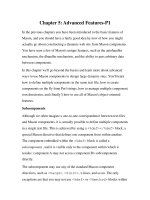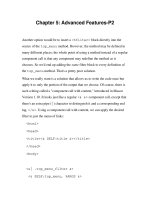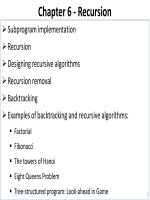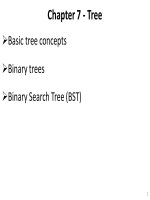Lecture Data security and encryption - Chapter 5: Advanced encryption standard
Bạn đang xem bản rút gọn của tài liệu. Xem và tải ngay bản đầy đủ của tài liệu tại đây (272.34 KB, 52 trang )
Data Security and Encryption
(CSE348)
1
Lecture # 5
2
Review
• have considered:
– monoalphabetic substitution ciphers
• cryptanalysis using letter frequencies
– Playfair cipher
• Cryptanalysis of Playfair Cipher
– Polyalphabetic Ciphers
– Vigenère Cipher
3
Aids
• Implementing polyalphabetic ciphers by
hand can be very tedious
• Various aids were devised to assist the
process
• The "Saint-Cyr Slide" was popularized and
named by Jean Kerckhoffs
• Who published a famous early text "La
Cryptographie Militaire" (Miltary
4
Aids
• He named the slide after the French
National Military Academy where the
methods were taught
• He also noted that any slide can be
expanded into a tableau, or bent round
into a cipher disk
• The Vigenère Tableau is a complete set of
forward shifted alphabet mappings
5
Aids
• simple aids can assist with en/decryption
• a Saint-Cyr Slide is a simple manual aid
– a slide with repeated alphabet
– line up plaintext 'A' with key letter, eg 'C'
– then read off any mapping for key letter
• can bend round into a cipher disk
• or expand into a Vigenère Tableau
6
Security of Vigenère Ciphers
• Vigenère & related polyalphabetic ciphers
still do not completely obscure the
underlying language characteristics
• Strength of this cipher is that there are
multiple ciphertext letters for each
plaintext letter
• one for each unique letter of the keyword
7
Security of Vigenère Ciphers
• Thus, the letter frequency information is
obscured
• However, not all knowledge of the
plaintext structure is lost
• The key to breaking them is to identify the
number of translation alphabets
• and then attack each separately
8
Security of Vigenère Ciphers
• If a monoalphabetic substitution is used
• the statistical properties of the ciphertext
should be the same
– as that of the language of the plaintext
• If, on the other hand, a Vigenère cipher is
suspected
• then progress depends on determining the
length of the keyword
9
Security of Vigenère Ciphers
• have multiple ciphertext letters for each
plaintext letter
• hence letter frequencies are obscured but
not totally lost
• start with letter frequencies
– see if look monoalphabetic or not
• if not, then need to determine number of
alphabets, since then can attach each
10
Kasiski Method
• For some centuries the Vigenère cipher was le
chiffre indéchiffrable (the unbreakable cipher)
• As a result of a challenge, it was broken by
Charles Babbage (the inventor of the computer)
in 1854
• but kept secret (possibly because of the
Crimean War - not the first time governments
have kept advances to themselves!)
• The method was independently reinvented by a
Prussian, Friedrich Kasiski, who published the
11
attack now named after him in 1863.
Kasiski Method
• However lack of major advances meant that
various polyalphabetic substitution ciphers were
used into the 20C
• One very famous incident was the breaking of
the Zimmermann telegram in WW1 which
resulted in the USA entering the war
• If two identical sequences of plaintext letters
occur at a distance that is an integer multiple of
the keyword length
• They will generate identical ciphertext
sequences
12
Kasiski Method
• In general the approach is to find
–
–
–
–
a number of duplicated sequences,
collect all their distances apart,
look for common factors,
remembering that some will be random flukes and
need to be discarded
• Now have a series of monoalphabetic ciphers,
each with original language letter frequency
characteristics
• Can attack these in turn to break the cipher
13
Kasiski Method
•
•
•
•
•
•
•
•
method developed by Babbage / Kasiski
repetitions in ciphertext give clues to period
so find same plaintext an exact period apart
which results in the same ciphertext
of course, could also be random fluke
eg repeated “VTW” in previous example
suggests size of 3 or 9
then attack each monoalphabetic cipher
individually using same techniques as before
14
Autokey Cipher
• Taking the polyalphabetic idea to the extreme,
want as many different translation alphabets as
letters in the message being sent
• One way of doing this with a smallish key, is to
use the Autokey cipher
• The example uses the keyword "DECEPTIVE"
prefixed to as much of the message
"WEAREDISCOVEREDSAV" as is needed
• When deciphering, recover the first 9 letters
using the keyword "DECEPTIVE“
15
Autokey Cipher
• Then instead of repeating the keyword, start
using the recovered letters from the message
"WEAREDISC“
• As recover more letters, have more of key to
recover later letters
16
Autokey Cipher
• Problem is that the same language
characteristics are used by the key as the
message
• ie. a key of 'E' will be used more often than a 'T'
etc
• hence an 'E' encrypted with a key of 'E' occurs
with probability (0.1275)2 = 0.01663
• about twice as often as a 'T' encrypted with a
key of 'T' have to use a larger frequency table
17
Autokey Cipher
•
•
•
•
•
•
•
ideally want a key as long as the message
Vigenère proposed the autokey cipher
with keyword is prefixed to message as key
knowing keyword can recover the first few letters
use these in turn on the rest of the message
but still have frequency characteristics to attack
eg. given key deceptive
key:
deceptivewearediscoveredsav
plaintext: wearediscoveredsaveyourself
ciphertext:ZICVTWQNGKZEIIGASXSTSLVVWLA
18
Vernam Cipher
The ultimate defense against such a
cryptanalysis is to choose a keyword
that is as long as the plaintext and has no
statistical relationship to it
Such a system was introduced by an
AT&T engineer named Gilbert Vernam in
1918
His system works on binary data (bits0
19
Vernam Cipher
The essence of this technique is the
means of construction of the key
Vernam proposed the use of a running
loop of tape that eventually repeated the
key
so that in fact the system worked with a
very long but repeating keyword
20
Vernam Cipher
Although such a scheme, with a long key,
presents formidable cryptanalytic
difficulties
it can be broken with sufficient ciphertext,
the use of known or probable plaintext
sequences, or both
21
One-Time Pad
• One-Time Pad is an evolution of the Vernam
cipher
• An Army Signal Corp officer, Joseph
Mauborgne, proposed an improvement using a
random key
• that was truly as long as the message, with no
repetitions
• which thus totally obscures the original message
22
One-Time Pad
• It produces random output that bears no
statistical relationship to the plaintext
• Because the ciphertext contains no information
whatsoever about the plaintext
• there is simply no way to break the code
• since any plaintext can be mapped to any
ciphertext given some key
23
One-Time Pad
• The one-time pad offers complete security but,
in practice, has two fundamental difficulties:
• There is the practical problem of making large
quantities of random keys
• And the problem of key distribution and
protection
24
One-Time Pad
• where for every message to be sent, a key of
equal length is needed by both sender and
receiver
• Because of these difficulties, the one-time pad is
of limited utility, and is useful primarily for lowbandwidth channels requiring very high security
• The one-time pad is the only cryptosystem that
exhibits what is referred to as perfect secrecy
25









